 Methamphetamine, sometimes called meth, crystal, crank, or ice, is a highly addictive stimulant. It emerged in the 1930s as a treatment for narcolepsy and depression and was also taken by German and Japanese soldiers in World War II to stay alert during battle, according to a DATIA focus article by Dr. Rodi Predescu, Quest Diagnostics. In the 1960s, people began to inject the drug to experience euphoria. Along with the explosion of crack-cocaine in the 1980s, meth continued to gain an audience of new users. In the past two decades, the abuse of methamphetamine has significantly increased. Although it is available by prescription, the majority of methamphetamine is produced and distributed illegally. The law requires all pharmacies and retail stores to monitor the sale of over-the-counter medicines with ingredients like pseudoephedrine because they are the key ingredients in the home-made of meth.
Methamphetamine, sometimes called meth, crystal, crank, or ice, is a highly addictive stimulant. It emerged in the 1930s as a treatment for narcolepsy and depression and was also taken by German and Japanese soldiers in World War II to stay alert during battle, according to a DATIA focus article by Dr. Rodi Predescu, Quest Diagnostics. In the 1960s, people began to inject the drug to experience euphoria. Along with the explosion of crack-cocaine in the 1980s, meth continued to gain an audience of new users. In the past two decades, the abuse of methamphetamine has significantly increased. Although it is available by prescription, the majority of methamphetamine is produced and distributed illegally. The law requires all pharmacies and retail stores to monitor the sale of over-the-counter medicines with ingredients like pseudoephedrine because they are the key ingredients in the home-made of meth.
Methamphetamine can be taken orally, smoked, snorted, or injected. Small amounts of the drug may cause increased physical activity, increased respiration, lack of appetite, rapid and irregular heart rate, and increased blood pressure. Repeated use may lead to anxiety, insomnia, weight loss, skin sores, and severe dental issues, referred to as “meth mouth.” Additionally, people who inject meth are at higher risk for contracting infectious diseases like hepatitis C and HIV. Addicts can suffer intense withdrawal symptoms when they detox and quit using methamphetamine.
The most current findings from the National Survey on Drug Use and Health tell us that:
- An estimated 8.2% of adults (aged 26 or older), or 17.1 million people, currently use an illicit drug
- About 128,000 young adults (aged 18-25) and 757,000 adults currently use methamphetamine
- About 22,000 adolescents (aged 12-17), 156,000 young adults, and 694,000 adults suffer from a methamphetamine substance-use disorder
According to the latest Quest Diagnostics Drug Testing Index™, methamphetamine, cocaine, and marijuana use has increased broadly in the American workforce, contributing to the highest positivity rate in 12 years. Although methamphetamine positivity in urine testing declined between 2005 and 2008 and plateaued between 2008 and 2012, it is currently steadily increasing. Between 2012 and 2016, methamphetamine positivity climbed 64% in the general U.S. workforce and 14% among federally-mandated, safety-sensitive workers. In oral fluid drug testing, methamphetamine positivity increased 75% between 2013 and 2016. Visit QuestDiagnostics.com/DTI for the full report.
Download our Quest Diagnostics Drug Testing Index brochure.
To learn more about drug testing, visit our website.
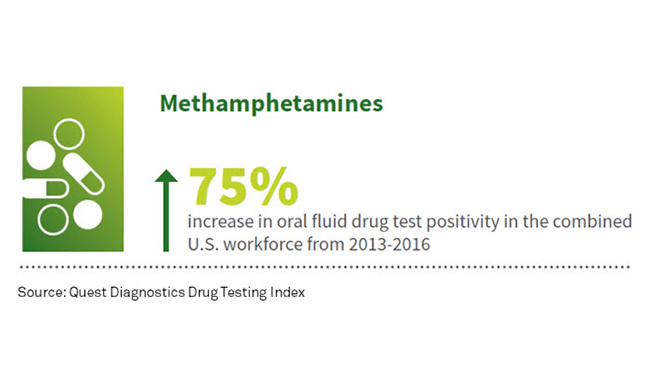
 Your Privacy Choices
|
Privacy Notices
|
Terms
|
Language Assistance / Non-Discrimination Notice | Asistencia de Idiomas / Aviso de no Discriminación | 語言協助 / 不䈚視通知
Your Privacy Choices
|
Privacy Notices
|
Terms
|
Language Assistance / Non-Discrimination Notice | Asistencia de Idiomas / Aviso de no Discriminación | 語言協助 / 不䈚視通知



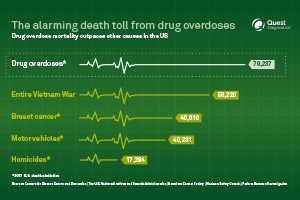





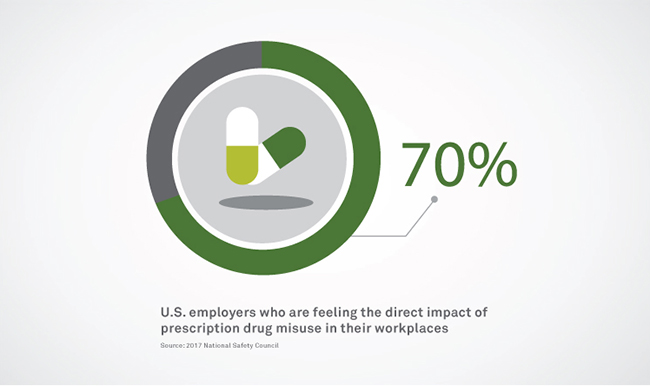



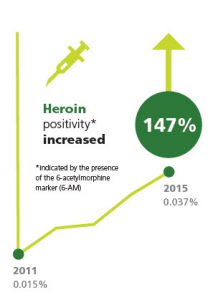
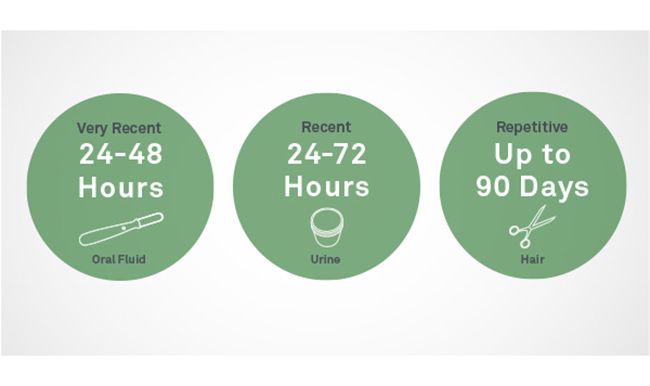




Methamphetamine can be taken orally, smoked, snorted, or injected. Small amounts of the drug may cause increased physical activity, increased respiration, lack of appetite, rapid and irregular heart rate, and increased blood pressure. Repeated use may lead to anxiety, insomnia, weight loss, skin sores, and severe dental issues, referred to as “meth mouth.” Additionally, people who inject meth are at higher risk for contracting infectious diseases like hepatitis C and HIV. Addicts can suffer intense withdrawal symptoms when they detox and quit using methamphetamine.
The most current findings from the National Survey on Drug Use and Health tell us that:
According to the latest Quest Diagnostics Drug Testing Index™, methamphetamine, cocaine, and marijuana use has increased broadly in the American workforce, contributing to the highest positivity rate in 12 years. Although methamphetamine positivity in urine testing declined between 2005 and 2008 and plateaued between 2008 and 2012, it is currently steadily increasing. Between 2012 and 2016, methamphetamine positivity climbed 64% in the general U.S. workforce and 14% among federally-mandated, safety-sensitive workers. In oral fluid drug testing, methamphetamine positivity increased 75% between 2013 and 2016. Visit QuestDiagnostics.com/DTI for the full report.
Download our Quest Diagnostics Drug Testing Index brochure.
To learn more about drug testing, visit our website.